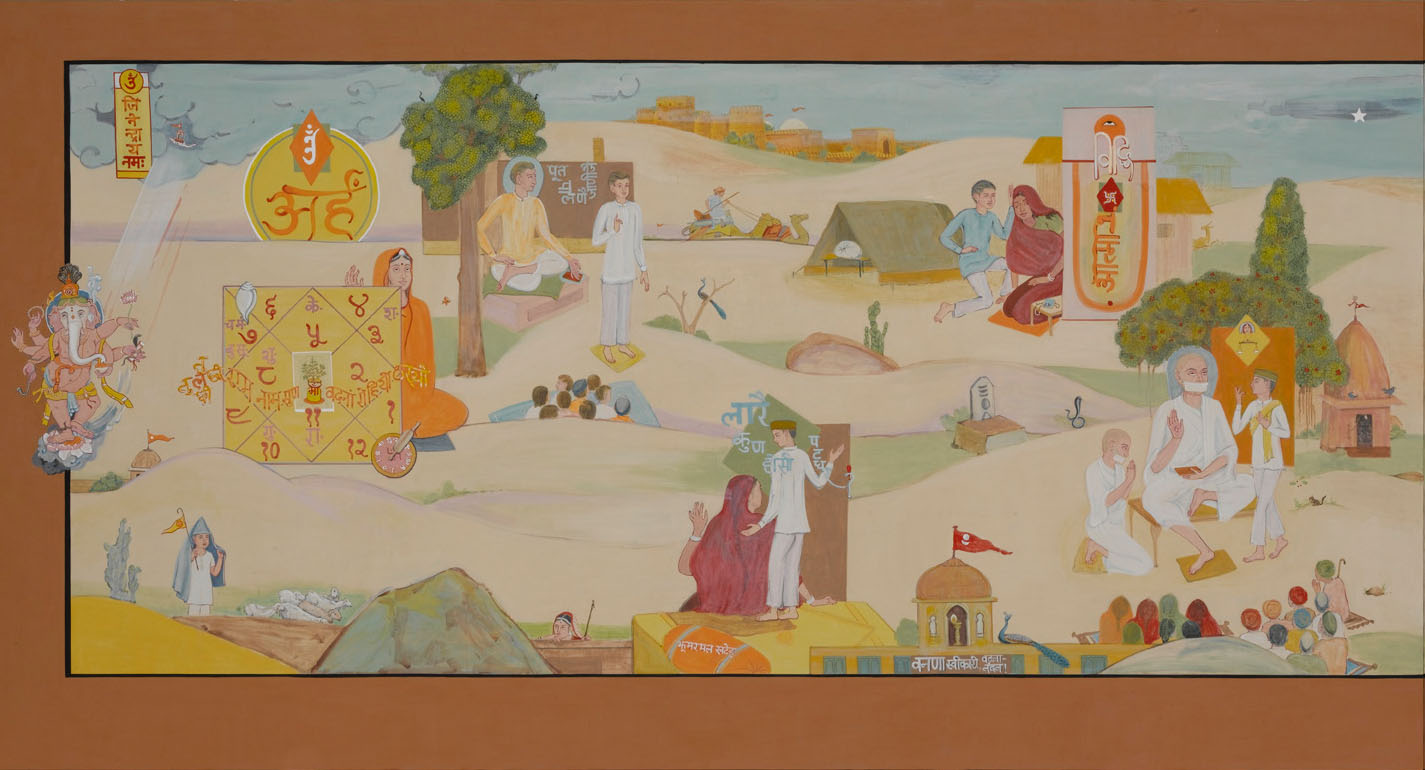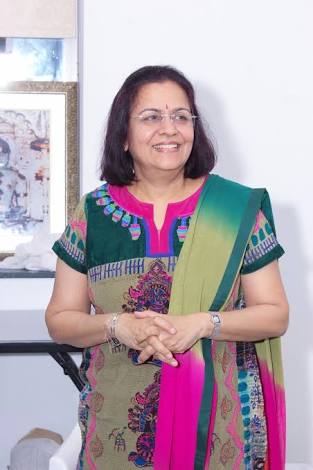Full Canvas
 See: www.herenow4u.net/index.php?id=57424
See: www.herenow4u.net/index.php?id=57424A GLORIOUS BIRTH

click to enlarge
The subject matter of this mural is the life of Acharya Tulsi. First, I have shown Yaksha (as protector) whose face resembles Ganesha’s. He is shown in a standing posture, with his left foot towards the space of the entire mural (signifying past) and his right foot towards the present. Yaksha’s ‘navel’ (i.e. the centre of energy) appears exactly at the centre of the mural (considered in its height). The theme of the painting, however, starts with a homage to ‘Jinendra’ (Om Jinendraya namah). A dream of the Dev-vimana, seen by Tulsi’s mother before his birth, appears on the right side of the homage.
This is followed by a mantra ‘Om Arham’ on a glorious sunrise announcing the birth of Tulsi (1914). Just below the sun, the horoscope of Acharya Tulsi contains a verse which reads: “Tulchhi Tulchhiram nam sun ma Vadana ro hiyo tharyo”(mother Vadana was pleased to hear her son’s name Tulsi). The word ‘Ma’ has been drawn on a pot containing a ‘tulsi’ plant. Behind the horoscope the mother is shown symbolically with her right hand raised in a blessing mudra. A conch-shell (top left corner of the horoscope) and a copper-thali (big plate) with a rolling-pin (right corner of the base-line of the horoscope), appear proclaiming the joyous news of a son’s birth. The time and place of the birth of Tulsi is written on that thali ‘1914, Ladnun’.
In the nether (lower) part of the mural a shepherd boy has been shown leading his sheep, metaphorically conveying a message that Tulsi will later lead a large human religious sect, suggested by a temple with a fluttering flag.
In the upper section, under a tree, Tulsi’s teacher is supervising Tulsi, teaching his class-mates. Behind Tulsi appears a saying - ‘Poot palane janije’ (a child is judged in the cradle). The peacock on a bare tree is present and it is considered in association with ‘Shrutadevi’. There is further suggestion that Tulsi in years to come will show his intellectual as well as spiritual gifts. Travellers riding on camels and sand dunes indicate the locale – Rajasthan of which Ladnun (his birth place) is a part. In the skyspace line a fort is painted to give just a hint of the past glories of the place.
In the nether part, on the arrival of Tulsi’s Acharya, Kalugani in Ladnun, Tulsi asks a question (hardly expected in a boy of his age approx. ten years) - “lare kun hosi patadhar?” (Who will be the next descendant of this Acharya?). His mother was amazed to hear the question and the extent of her amazement is shown in the use of two punctuation marks: exclamatory and interrogative. His father’s name, ‘Jhumarmal Khater’ is written on an embroidered pillow.
In the upper part of the painting young Tulsi is consoling his sister Ladanji who has lost her husband soon after her marriage. A calligraphy of ‘Atmanam Vidhi’ (know thyself), obviously a consolatory message in her bereavement, is imaginatively used to show the depth of Tulsi’s knowledge at such a stage in his life. One will notice a tent drawn behind Tulsi, consoling his sister only to emphasize the transitoriness of life. Before I further move, a personal homage to Vadana-nandana (Tulsi), is humbly offered by me in the lower section.
When Acharya Kalugani entered Ladnun, he came across a big black snake on his right hand side (a sign of good-luck), which manifested itself when Tulsi decided to become his disciple.
As a rule of Terapanth sect, no Acharya can give Diksha-mantra to a disciple without the permission of his guardians. Keeping this in mind the boy Tulsi, one day stood during the sermon and took two vows:
- he would never marry and
- he would never do business, (a woman, as shown here, signifies marriage and a weighing scale, business).
The depiction of a glowing polar star in the sky at the top corner of the frame shows Tulsi’s firmness in his determination, aim and purpose.
 Dr. Manju Nahata
Dr. Manju Nahata